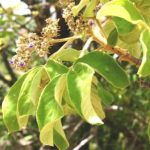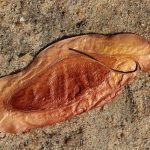TREE LIFE
January 1998
MASHONALAND CALENDAR
Saturday 3rd January. Mark’s subject on this walk will be ferns. Domboshawa is rich in ferns so if you have a fern book bring it along and learn some more about them.
On previous visits the entrance fee was $3.
Tuesday 6th January. Botanic Garden Walk. This month Tom starts a series on some of the trees of the Lowveld. We will meet Tom in the car park at 4.45 for 5.00 p.m. and there will be a guard for the cars.
Sunday 18th January. Once again we are privileged to visit John and Lillian Cottrill’s farm in the Mtepatepa district. Apart from checking the progress in the rocky area where John has planted many species of indigenous trees, we hope to visit the nearby dam. John’s collection of water lilies from around the world is legendary.
Saturday 31st January. Mark’s Botanic Walk.
Tuesday 3rd February. Botanic Garden Walk. Saturday 28th February. Mark’s Botanic Walk.
MATABELELAND CALENDAR
January 1st. New Year social. This will take place at the residence of Jonathan and Jenny Timberlake Matsheumshlope from 11.Am.
Wednesday 7th January. On the first Wednesday of each of the next 6 months, one episode of the wonderful video The Private Life of Plants will be shown at Girls’ College at 7.30 for 8 p.m. The episodes have enchanting titles such as Travelling; Growing; Flowering; Social Struggle; Living together; and Surviving.
January 29th to 1st February. Visit to Sentinel Ranch near Beitbridge – a long weekend or longer. A family house is available for our use with 8 beds and mattresses and garden to camp in. Water, electricity, stove and fridge are available. One bathroom, plates and cutlery available otherwise self-catering. Cost $50 per night per person. Please make contact with Jonathan or Anthon for further details or to indicate you wish
Sunday February 1st. Visit to Chipangali where we have been invited to assist in the development of an indigenous tree wood
BIRD SANCTUARY – LAKE CHIVERO 16 NOVEMBER 1997.
Once again a belated start – SOMEBODY forgot the key … sorry for that! The key was eventually collected although the idea of the Tree Society slipping through the fence in full view of the National Parks staff would be most amusing.
The Bird Sanctuary consists mainly of mature Miombo woodland, patchy in places with sandy soils that also support numerous but scattered termitaria, some of notable size with active subterranean workings. With all termite mounds the availability of trace elements and moisture encourage vegetation and here large specimens of Albizia amara occupy the upper mound with the fringe colonized by a variety of familiar species, Ziziphus mucronata, Acacia sieberiana, Acacia karroo,
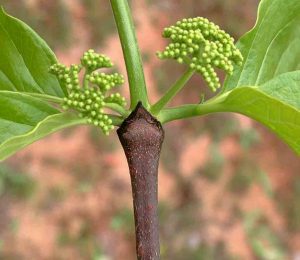
Afrocanthium lactescens. Photo: R.Burrett. Source: Flora of Zimbabwe.
Canthium lactescens, now Afrocanthium lactescens, Diospyros lycioides, Schotia brachypetala and Dovyalis zeyheri, complete with the telltale ‘race tracks’ of the leaf miner. Less commonly noted is the Capparaceae, Maerua triphylla, which produces a shaving brush flower with exerted floral parts. The petiole is long and slender and the 3-foliate leaf bends away from the petiole at an acute angle.
Something requiring more than a casual glance and the use of the new list of name changes are the Cassine family being Crocoxylon transvaalense and Mystroxylon aethiopicum and if the name changes disturb you then remember the “oxolon”! Fortunately the Wilson’s seem to take the Sunday outing seriously having a neatly folded name change list within the folds of a volume of a favoured tree book. Clerodendrum glabrum, known for its obnoxious odour when its leaves are damaged is to be found in this tangle of plants and a discussion arose regarding its antiseptic properties, however, a reference to Michael Gelfand’s The Traditional Medical Practitioner does not list this use, indeed its use in traditional medicine is uncommon, one recorded case of a root infusion being used to treat mental illness in the Mashava district resulted in a Sudden Death Docket being opened in March 1975.
In the last few years some small areas within the woodland have been opened up, whether by fire or clearing operations is difficult to establish, however, the silver Terminalia colonises these zones efficiently. Despite most of the Terminalia sericea displaying typical features of silky leaves clustered on terminal branchlets that peel (remember the tweeling pigs) some others appear to differ to the textbook definition and have smooth leaves and minimal peel! Galls are another feature of this species and can be roughly grouped in two distinct types:
A small (1cm) gall being formed against new growth (meristem) by the plant reacting to the presence of insect larvae. It was not possible to find out the insect species responsible, however, these bugs when mature experience the outside world once they are able to gnaw their way through the tough skin of the gall using their mandibles. The other larger growth forms on new terminal growth and is frequently the home of a wasp, this time an old gall found hanging nearby provided the remains of a pupal skin left by a very small wasp on emerging from the ostiole, 0.5mm in diameter as tested with a Japanese pencil lead – guaranteed size!
Another feature of the area colonised by Terminalia regrowth are the dense stands of young slender Mukwa and this poses the question – could this have been triggered by a hot fire (?), after all this plant species belongs to the legume subfamily Papilionoideae. A number of Jacarandas have found their way into the area from the surrounding farms but having no natural predators is one of the most rampant invaders in Southern Africa and a serious problem especially in wetter parts of the region such as Natal. At the waters edge a thicket of Ziziphus, Capparis tomentosa and Phytolacca dodecandra form a hide, the tangle below having been cleared by some thoughtful person and from it a good view of the shallow pan with several resident water birds, Jacana and White-faced duck and for background noise the Piet my Vrou and Heuglin’s Robins in the woodland.
A pleasant place with lots to interest and thanks to the OAZ for permission to use the site and thanks to Mary for explaining the development of Terminalia galls.
-Andy MacNaughtan
BOTANIC GARDEN WALK: 2 NOVEMBER 1997.
The last part (no. 3) of figs, and after a presentation to Tom to thank him for his patience and hard work in conducting the Society around the gardens every month, we set off to finish off the figs.
Firstly a very rare Fig.
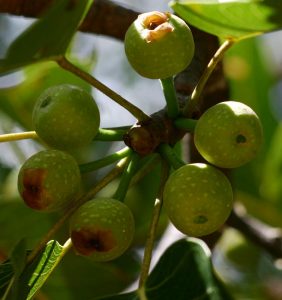
Ficus fischeri. Photo: Bart Wursten. Source: Flora of Zimbabwe.
Ficus fischeri. This occurs in forest outliers between Mt. Selinda and the Save Valley. It has relatively broad leaves and long petioles and somewhat warty figs. It looks a bit like Ficus polita, which we were to see later in the walk.
Next, Ficus natalensis. This belongs to the thonningii/craterostoma complex, which contains many puzzling forms. In Zimbabwe, it usually has a markedly truncate leaf apex (although not always) and this generally serves to distinguish it from the very common Ficus thonningii.
On to Ficus abutilifolia, with its more or less spherical, often very large, leaves with a cordate base. This is a common and well-known species of rocky places. Somewhat similar, is Ficus tettensis, also seen on the walk, where it was just coming into leaf, but this species has much smaller leaves. It, too, occurs in rocky places.
Another species of rocky places is Ficus glumosa. Tom remarked that this is a real rock-splitter. Usually recognised by the densely hairy twigs. It is a fairly frequently seen species.
Ficus polita, on the other hand, is a very rare species in Zimbabwe indeed. Tom, on the Eastern Highlands Tea Estate, in the E. Districts, has found it once. Perhaps most noticeable was the acuminate apex and the long petiole. It is a species of low-altitude evergreen forest.
Tom also showed us two distinctive non-Zimbabwean species. Ficus ottoniifolia has remarkable egg-shaped figs marked with pale spots. It occurs in Zambia. Ficus cyathistipula, from Zambia and Malawi, has persistent relatively large stipules on the twigs.
Next month, at the start of 1998, we hope to look at lowveld trees. Once again, our thanks to Tom for giving up his time for the society.
-Mark Hyde
TALKING OF TREES
Gonarezhou is big game country, mostly elephant, but it is also big tree country with Baobab featuring strongly, and the game-viewing visitor is inevitably drawn to the shade of the splendid riverine trees like the wild mango Cordyla africana, and the Nyala berry Xanthocercis zambesiaca for which the Park is so well renowned.
If you consider yourself to be anything of a naturalist, you will have had the joy of seeing the isolated colony of African mahoganies Milicia excelsa just upstream from the Nyahungwe camp on the Lundi River. These lofty giants stand out majestically from the rest of the riverine vegetation like noble strangers, which indeed they are for their true home lies in the tropical forests of East Africa. If you are an even greater enthusiast, you will have walked further upstream and witnessed the forest of Newtonia hildebrandtii (Lebombo wattle), now protected in South Africa. It is true that the riverine forest will capture the attention of most visitors, but for the amateur ecologist there is an equal wealth of interest in the woodland away from the river.
Take for example the short journey of a few kilometres from Kundani Hill in the lower Lundi section to the plateau above. This solitary hill rises out of an extensive plain of scrub mopane little taller than a man’s shoulder. In a distance of no more than four kilometres the altitude rises from 250m above sea level to 300 asl. One could not find a lower and hotter area in Zimbabwe. For comparative purposes, Chiredzi is a little over 400m asl and Harare approximately 1500m asl. On this road you will discover a fascinating transition of tree species, from the arid and stunted mopane at the lower elevations to the exciting and surprising woodland climax on the deep sands of the plateau itself. Continue on your way and you will find that at first the scrub gives way to strong mopane woodland, and then Terminalia sericea, Marula Sclerocarya birrea, rooibos (red bushwillow) Combretum apiculatum and Tamboti Spirostachys africana, appear together with the spectacular red autumn leaves of Diospyros usambarensis. A ‘kanniedoodnie’ Commiphora appears. But all these species are not surprises to the Lowvelder as they are common throughout the region.
Soon the bastard mopane Guibourtia conjugata appears, then a pod mahogany Afzelia quanzensis and then around a steep bend in the road, a strong specimen of Mnondo, Julbernardia globiflora confronts the traveller.
Still, you will say, these are common lowveld trees even after you see the Cassia abbreviata with its fine yellow blossoms and the mountain acacia which is not of course an acacia at all, but Brachystegia glaucescens.
And then you surely will be surprised for there, suddenly, is a Msasa. Yes, the real
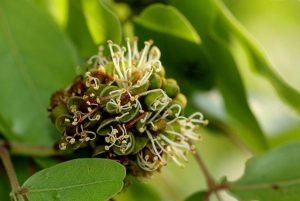
Brachystegia spiciformis. Photo: Bart Wursten. Source: Flora of Zimbabwe.
Brachystegia spiciformis, which, you will argue, really belongs to the far off well-watered Highveld regions of Mashonaland, to the tobacco growing regions in fact. And you will ask what that tree is doing here in this lonely spot. The answer unquestionably “lies in the soil”! The plateau upon which you now find yourself is characterised by extensively deep sandy soils, which shed virtually none of the meagre incidental rainfall, as evidenced by the lack of watercourses. Trees like Msasa can tap the deep horizons for their water supplies and so can survive and even thrive in what is in other respects a typically dry environment.
The Msasa, truly, has a wide range of adaptability. It is strongest on the deep fertile soils of the well-watered highveld but it also occurs extensively in Nyanga and Chimanimani highlands although noticeably stunted by the cold there. And yet here you can stand in its shade and feel its rough bark and break its brittle pods underfoot in this hot, dry country.
Before you become nostalgic for more recreational climes, you must move on and you will see more old friends in the form of Mukwa (kiaat to South Africans Pterocarpus angolensis to botanists and prized furniture wood to connoisseurs!); and the wing-pod tree Xeroderris stuhlmannii very common in the lowveld, the fruit of which very often fools the beginner by manifesting both spherical (galls) and flat pods. The duiker-berry Pseudolachnostylis maprouneifolia is there too with its beautiful autumn shades if you pass that way in August. A short distance on you will cross a depression where mountain acacia dominates – not large specimens it is true but here this tree is growing in a peculiar habitat apparently in strong contrast to the accustomed places where they occur like sentinels on high, well-drained ground.
And then you will see what must be one of the strangest associations of all – Msasa and msimbiti growing side by side! Msimbiti, the ironwood exclusive to the Lowveld (Androstachys johnsonii) is normally found on our sandstone outcrops where it survives under extremely arid conditions, somewhat stunted, and you may well wonder why this tree is growing here alongside Msasa. It is true that a single swallow does not make a summer, but you will see not one msimbiti specimen, but several and all of a goodly size. The answer to this riddle lies, I think, not this time in the soil, but in the fact that meaningful fire is virtually absent from this particular habitat. The grass cover on these deep sands is poor and sporadic, partly on account of the strong competition from the trees and partly to the poor water-holding capacity in the upper soil horizons that the grasses exploit. The result is that fires are seldom fierce and thus msimbiti, which is very sensitive to fire, can thrive here. The distribution of msimbiti is limited by two factors – firstly by cold, as it can only thrive in frost-free areas; and secondly by freedom from fire. Interestingly, dry msimbiti wood burns very strongly with a smoky flame suggesting a high concentration of waxes in the wood. It is not used for cooking fires for it imparts unpleasant flavours, but it can be held aloft as a burning torch as the flame is not
Now, having understood how these two have chosen to be bedfellows in this strange place, let us continue on our journey. Not far along the track you will be surprised by an almost pure stand of Millettia stuhlmannii much coppiced with smooth, light coloured bark and large, flat, golden pods hanging in clusters pendulantly. This is a very uncommon tree for Lowvelders, being the much prized panga-panga wood of Mozambique, dark in colour and used extensively for parquet flooring and, more interestingly, used for the bar counter at Mkwasine Club. Doubtless many would prefer to witness it in the latter position than at this end point of our short but thirsty journey.
-John Wilson.
Acknowledged with thanks to the Hartebeest, magazine of the Lowveld Natural History Society 1984 No 16.
VISIT TO MAZWI NATURE RESERVE SUNDAY 7 DECEMBER
10 cars made the trip out to Mazwi, which lies to the east of Khami prison and borders on Pasipas siding near the Nyamandhlovu road.
A relatively new Nature Reserve near Bulawayo, Mazwi contains several varying habitats including riverine, acacia bushveld and Kalahari sand interspersed with Karroo sandstone, sandstone and basalt outcrops.
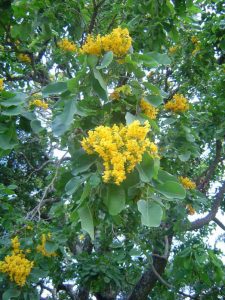
Pterocarpus rotundifolius. Photo: B. Wursten. Source: Flora of Zimbabwe.
On this trip we tried to concentrate on only a few species which were Baikiaea plurijuga (Zambezi teak), Kirkia acuminata (white Syringa) and Burkea africana (red Syringa?)
Jonathan held forth on these three species with contributions on various aspects of the bark normal and otherwise, the flowers, fruits and foliage coming from Anthon and Clem. Stress was put on the distinguishing features of each species. As it was only a half-day visit we did not have time for much more treeing except to wonder about the identity of some strange looking, which did not have very rotund leaves –Pterocarpus rotundifolius subsp. polyanthus var. martinii perhaps. They certainly looked different, growing in Kalahari sand, from the ones we see elsewhere growing on granite and other rocky outcrops.
Some of us made it as far as a small hill of basalt where the species diversity was greater.
Mazwi is certainly worth a whole day visit at a later stage.
-Anthon Ellert.
AMAZONIAN TREES PAY THE PRICE OF ANT GUARDS
Mutually beneficial relationships between ants and plants have been known for over a century. In the most studied cases, such as the acacias, the plants live in open habitats and produce food for the ants, which in return defend the plants against leaf-eating insects and mammals. However, according to a Brazilian zoologist, the ant-plant relationships found in the Amazonian rainforests are more complex (Journal of Ecology, vol. 82, p 833).
Carlos Roberto Fonseca studied the Amazonian rainforest tree Tachigali myrmecophila.
A stinging ant, Pseudomyrmex concolor, occupies hollows in its leaves. Although the tree provides no food for the ants, the insects nevertheless mount 24-hour patrols, attacking all creatures that disturb the tree, whether they are other insects or mammals. The tree has a very low growth rate and spends most of its life as a sapling in the rainforest understorey. It reproduces only once, just before it dies.
The ants do not eat the leaf-eating insects they capture but prey on a colony of coccids they keep inside their nest. These produce honeydew from the phloem of the tree, and this is the ants’ main source of energy. The tree feeds the ants only indirectly, and in the past some biologists have suggested that this particular ant-plant relationship is not mutually beneficial.
But by conducting an experiment in which some trees were kept ant free for 18 months, Fonseca was able to show that the ants’ presence is indeed beneficial to the tree. He found that trees without ants suffered at least twice as much leaf loss as those with ant colonies. The overall effect of removing the ants was to shorten the life of a tree’s leaves by about 50 per cent and to slow their rate of growth, presumably by reducing the leaf area able to carry out photosynthesis.
Fonseca believes that the cost of ant protection to rainforest trees is probably greater than that to acacias because they have to support the coccids as well as the ants. However, in the poorly lit rainforest understorey, the loss of leaf area may be more serious than in more open habitats. So for Amazonian trees, recruiting ant protection seems to be a cost worth paying and is probably less than the cost of photosynthesis loss due to leaf-eating insects.
-John Timson This extract from New Scientist 7 January 1995
FOR SALE.
Rolf Chenaux-Repond has an extra copy of the recently released book Field Guide to the Trees of Southern Africa by P. van Wyk and B. van Wyk. The cost in the shops is $399.95. Ralph would like $375.00. Contact him at home on 303591 Harare or at work on 663325.
Advance notice of an increase in Subs.
Following the unbelievable increases in postal rates, the annual subs will unfortunately also have to rise; hopefully to a level where our members still feel they are getting their money’s worth. The new rate, which will be decided at the next committee meeting, will come into effect on 1 April 1998.
ANDY MACNAUGHTAN CHAIRMAN


